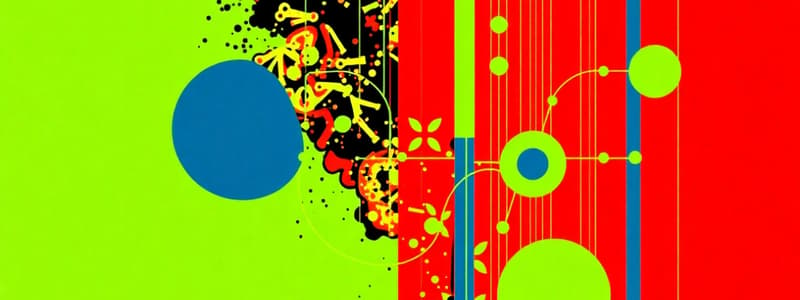Podcast
Questions and Answers
Nondeterministic Finite Automata (NFAs) can recognize which class of languages?
Nondeterministic Finite Automata (NFAs) can recognize which class of languages?
- Only context-free languages
- Regular languages and some non-regular languages (correct)
- Only recursive languages
- Only regular languages
What is the primary distinction between Mealy and Moore machines in the context of state machines?
What is the primary distinction between Mealy and Moore machines in the context of state machines?
- Their output depends solely on states or both states and inputs respectively (correct)
- Their number of states required for processing inputs
- Their ability to process input symbols only once each time they read them
- Their acceptance criteria for input strings
Which of the following properties does not generally hold true for regular languages?
Which of the following properties does not generally hold true for regular languages?
- Closure under union
- Closure under context-free grammars (correct)
- Closure under intersection
- Closure under complementation
Why is the Turing machine considered a powerful theoretical model of computation?
Why is the Turing machine considered a powerful theoretical model of computation?
Given an alphabet Σ (e.g., Σ = {0, 1}), what term describes the set of all possible strings that can be formed using symbols from Σ?
Given an alphabet Σ (e.g., Σ = {0, 1}), what term describes the set of all possible strings that can be formed using symbols from Σ?
Which of the following accurately describes sets that can be enumerated by an algorithm but not necessarily decided?
Which of the following accurately describes sets that can be enumerated by an algorithm but not necessarily decided?
Which type of grammar is capable of generating languages that are not regular?
Which type of grammar is capable of generating languages that are not regular?
Which of the following is NOT a standard operation performed on formal languages?
Which of the following is NOT a standard operation performed on formal languages?
Under what condition does a string belong to the language produced by a particular grammar?
Under what condition does a string belong to the language produced by a particular grammar?
In formal language theory, what does 'derivation' specifically describe?
In formal language theory, what does 'derivation' specifically describe?
Which of the following abstract machines relies on states and transitions triggered by input symbols to process data?
Which of the following abstract machines relies on states and transitions triggered by input symbols to process data?
What are the fundamental components that constitute a context-free grammar?
What are the fundamental components that constitute a context-free grammar?
What criterion defines two grammars as 'equivalent' in formal language theory?
What criterion defines two grammars as 'equivalent' in formal language theory?
Consider a DFA. What does its transition function primarily map?
Consider a DFA. What does its transition function primarily map?
What is the minimum number of states required in a DFA to accept all strings over the alphabet {0, 1} that contain the substring '101'?
What is the minimum number of states required in a DFA to accept all strings over the alphabet {0, 1} that contain the substring '101'?
An NFA's transition function differs from a DFA's in that it returns:
An NFA's transition function differs from a DFA's in that it returns:
Which statement is always true regarding Deterministic Finite Automata (DFAs)?
Which statement is always true regarding Deterministic Finite Automata (DFAs)?
In the context of automata theory, what does an 'accepting state' signify?
In the context of automata theory, what does an 'accepting state' signify?
Which type of automaton is specifically designed to recognize regular languages?
Which type of automaton is specifically designed to recognize regular languages?
In which kind of automaton are epsilon ($\epsilon$) transitions permissible?
In which kind of automaton are epsilon ($\epsilon$) transitions permissible?
What is the key implication of the equivalence between DFAs and NFAs?
What is the key implication of the equivalence between DFAs and NFAs?
Flashcards
Nondeterminism in Automata
Nondeterminism in Automata
Can recognize regular languages and some non-regular languages using nondeterminism.
Mealy vs. Moore Machines
Mealy vs. Moore Machines
Output depends on current state only vs. current state and input.
Regular Language Closure
Regular Language Closure
Regular languages are not closed under context-free grammars.
Turing Machine Power
Turing Machine Power
Signup and view all the flashcards
Universal Language
Universal Language
Signup and view all the flashcards
Recursively Enumerable Sets
Recursively Enumerable Sets
Signup and view all the flashcards
Context-Free Grammar
Context-Free Grammar
Signup and view all the flashcards
Not an Operation on Languages
Not an Operation on Languages
Signup and view all the flashcards
String Belongs to a Language
String Belongs to a Language
Signup and view all the flashcards
Derivation (Formal Language)
Derivation (Formal Language)
Signup and view all the flashcards
Finite Automaton
Finite Automaton
Signup and view all the flashcards
Context-Free Grammar Components
Context-Free Grammar Components
Signup and view all the flashcards
Equivalent Grammars
Equivalent Grammars
Signup and view all the flashcards
FSM tuples
FSM tuples
Signup and view all the flashcards
DFA transition function
DFA transition function
Signup and view all the flashcards
DFA for strings ending in '10'
DFA for strings ending in '10'
Signup and view all the flashcards
NFA Transition Function
NFA Transition Function
Signup and view all the flashcards
DFA transitions
DFA transitions
Signup and view all the flashcards
Accepting State
Accepting State
Signup and view all the flashcards
Machine for Regular Languages
Machine for Regular Languages
Signup and view all the flashcards
Epsilon Transitions
Epsilon Transitions
Signup and view all the flashcards
Study Notes
- A finite state machine has 5 tuples.
- The transition function of a DFA maps Q * Σ -> Q.
- A DFA accepting strings ending with "10" requires a minimum of 3 states.
- An NFA's transition function returns a set of states.
- A DFA has exactly one transition for each symbol in the alphabet from every state.
- In automata, the 'accepting state' is where the input string is accepted if the automaton ends there.
- Finite Automaton machines are used for recognizing regular languages.
- Epsilon transitions can occur in an NFA.
- DFA and NFA equivalence means they accept the same set of strings.
- A Mealy machine produces output based on input and next state.
- Regular grammars generate all regular languages.
- Chomsky Normal Form has production rules either A → BC or A → a.
- The union operation on languages results in strings that are in either language.
- Recursive enumerable sets can be enumerated by some algorithm but are not necessarily decidable.
- Context-sensitive grammars can generate non-regular languages.
- Derivation is not an operation on languages.
- A string belongs to a language generated by a grammar if it follows all rules defined and can be derived.
- Derivation refers to the sequence of production applications leading to a string from the start symbol.
- Turing Machines use states and transitions to process input symbols.
- A context-free grammar consists of variables, terminals, a start symbol, and production rules.
- Equivalent grammars generate exactly the same language.
- In Deterministic Finite Automata, every transition leads to exactly one next state.
- The pumping lemma is used to prove that certain languages are not regular.
- Pushdown Automata accept context-free languages.
- An NFA accepts regular languages and some non-regular languages through non-determinism.
- The output of a Mealy depends on both states and inputs whereas the Moore depends solely on states.
- Closure under context-free grammars does not hold for regular languages.
- A Turing machine is powerful because it can simulate any algorithm.
- The set of all strings over an alphabet ∑ is known as a Universal Language.
- 'Closure' refers to the operations applied to sets resulting in new sets within the same family.
Studying That Suits You
Use AI to generate personalized quizzes and flashcards to suit your learning preferences.





